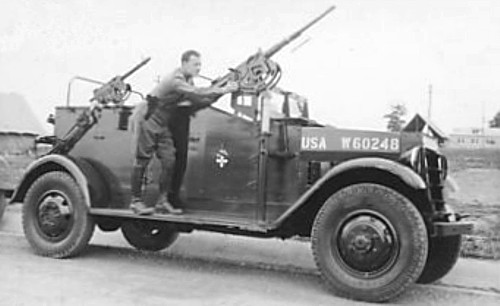 The story US Army armoured cars is not limited to the M8 Greyhound. And although WW2 leaned more on armoured warfare with tanks, they are better remembered; extreme mobility violently contrasted with the character of trench warfare in WW1 and so armoured cars had less priority in general. But this did not prevented continuous experiments in the thirties in particular. When the US saw Europe at war again in 1939, armoured cars in US service were few and far between, and they had been relegated to the cavalry corps. The only sizeable model at that stage was the M1 derived from the Cunningham T4/T5 in 1931: Only 12 were available, plus numerous prototypes or models seeing an equally small production like the White AC or the Marmon Herrington T13.
The story US Army armoured cars is not limited to the M8 Greyhound. And although WW2 leaned more on armoured warfare with tanks, they are better remembered; extreme mobility violently contrasted with the character of trench warfare in WW1 and so armoured cars had less priority in general. But this did not prevented continuous experiments in the thirties in particular. When the US saw Europe at war again in 1939, armoured cars in US service were few and far between, and they had been relegated to the cavalry corps. The only sizeable model at that stage was the M1 derived from the Cunningham T4/T5 in 1931: Only 12 were available, plus numerous prototypes or models seeing an equally small production like the White AC or the Marmon Herrington T13.
Early on, others were tested such as the "Dodge Armored Car" by Troop A, 1st Armored Car Squadron, 1st Cav. Div. in Fort Bliss (Texas), in 1930, but also a derivative with a full wheel protection arrangement developed by the 112th Cavalry in 1932 (by Capt. John Dunlap, Machine Gun Troop). There were also two Car, Armored, T8 based on a Chevrolet chassis (USA W-1307 and USA W-1308) the latter being converted to the T9. The latter reused the same body on a Plymouth chassis.
A far cry to the M3 Scout Car produced in 1940, at first to answer lend-lease orders: 20,918 until 1945. The M2 and M3 half-tracks were soon made in large quantities (13,500+56,500) by just swapping flexible Kegresse type tracks on the rear axis. However these were ancestors of modern APCs (armoured personal carriers) and offered little protection. Soon, a major program for a proper reconnaissance car was engaged, to which most car manufacturers from coast to coast participated;
The winner was (perhaps understandably so) Ford, which had the muscle necessary to pull out the production of 8,520 M8 Greyhound in 1943-45 the "grey ghost", and its command version the M20. And there was also the T17E1 Staghound, only one of numerous heavy armoured cars in the "hound" serie by all manufacturers, to see the light of day. Less known, it was mass produced (4,000) but not standardized as it never was used by the US, but British, commonwealth or allies at large instead. That is, in essence the whole story of US armoured cars for two decades. However it would be grossly underappreciate the cohort of prototypes, some mediocre, other excellent, which never saw the light of day due to multiple reasons. This post is going to tackle this issue by an exhaustive review of all US Army armoured cars between the early interwar and 1945.
Introduction
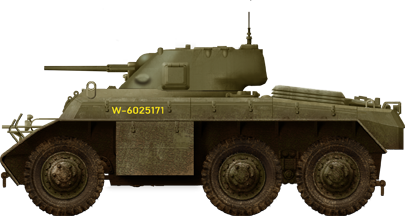
T17 Deerhound, prototype for a lend-lease armoured car, complementary to the M8, 1942
The US Army gave as much credit to armoured cars than tanks when exiting the great war. If the latter were better adapted to trench warfare, their relativaly late arrival in late 1917 and early 1918 only had little time to adapt to static warfare, as the failire of the spring offensive was counterbalanced by a massive entente push towards Germany and the Hindenburg Line, which was be broken by the most massive armoured push the world had ever seen. In this context, armoured cars were still useful to control the road network in retaken territories and when a breach was made, push deep forays into enemy lines.
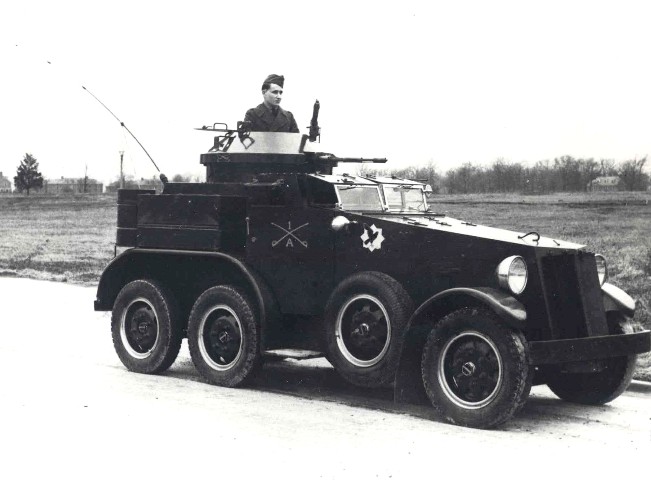
M1 Armoured Car, used by the cavalry in the thirties.
Back on US soil, armoured cars like tanks however faced the abrupt end of military spendings, but the roaring twenties were not exempt of troubles; Armoured cars were deployed in more than one occasion for crown control, a role in which they excelled, when tanks were not used. The latter had troubles with their tracks in urban areas, so the armoured cars, cheaper, easier to maintain and much faster, seemed far more appropriate. In the 1920s there were "legacy armoured cars" that were still around: The Jeffery, White, King, Davidson Cadillac, Ford, Dodge and Mack Armoured Cars, among others that actually made it in limited production of some sorts and were still adequate for Peacetime use in the US.
The US Army, and in particular its cavalry branch looking to gradually motorize its units, saw the type quite favourably, especially after a law was passed to forbid this corps any use of a tank. This came back to haunt them in 1936 when light, very fast tanks for reconnaissances were to be issued to further modernize cavalry regiments when it was realized fast tanks were possible and could overcome all terrains, unlike cars. They were named "armoured cars" officially to circumvent this interdiction. Only with the M3 scout car, the army had a numerous model, later declined into half-tracked APCs, but the M8 Greyhound in 1943 only seems to match the public definition. So, without further ado, here is the full picture, all US armoured cars from 1920 to 1945:
Introducing video
 T11/T11E1/T11E2 Armoured Car (1932)
T11/T11E1/T11E2 Armoured Car (1932)
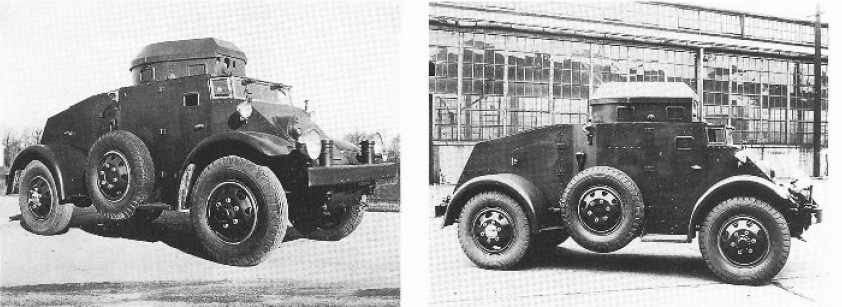
The search for a low cost, lightweight armored car for potential contracts for the army led the "Four Wheel Drive Auto Company" to design the T11 in 1932, as a rival to the current standard M1 car. With an armoured thickness, integral, of 1/4 inches (6.25 mm) for 70 mph with space for a working turret. However, persistent mechanical problems prevented any production. The army authorized still further development, leading to the T11E1, to fix issues and six test vehicles were modified and sent to Aberdeen for testing in late 1934. They notably had better cooling, a 3/8 inches (10 mm) armour, and larger, better tires. In 1936 a single T11E2 was built as simplified production prototype, but army still judged performances sufficient, and the program never went further.
Specs:
Cadillac V8 (115 hp); Hercules WXLC3 (115 hp), 111 km/h, weight 5.1 ton, size unknown.Gun turret for a .50 Caliber MG HB M2, 6 or 10 mm protection, crew 3 (Driver, Gunner, Commander)
 Cunningham M1 Scout Car (1934)
Cunningham M1 Scout Car (1934)
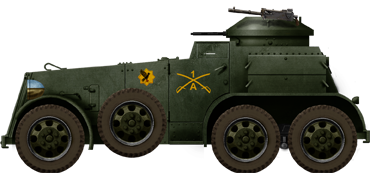
In 1931, the US Army Ordnance ordered two prototypes from James Cunningham, Son and Company of Rochester, New York. The vehicles were delivered in 1931, tested until 1934 as the T4. Ten were produced afterward and standardized as the M1 Armoured Car at Rock Island Arsenal (chassis numbers W-60114 to W-60125) so 12 vehicles still in service in WW2 which stayed in the US notably at Fort Riley, Kansas.
Specs:
 White M1 Scout Car (1935)
White M1 Scout Car (1935)
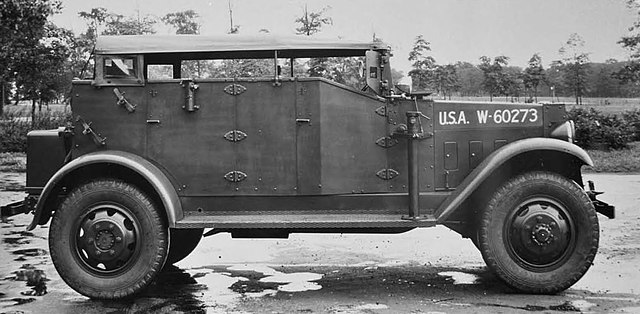
Ordered by the US Army Ordnance also in 1931, but to Indiana Motors (White Motor Car Company). Three prototypes T7 delivered and tested 1933-34. This vehicle was standardized as the production model of the Car, Scout, T7 in 1935. 76 production M1 were delivered, still active in WW2, but never leaving the US.
Specs:
Engine: 6-Cylinder Gasoline (Hercules JXC), speed 50 mph, 80 kphCrew: 2-4
Armament: 0.5 cal. HMG, 2x .30 caliber Light MG's
 White M2 Scout Car (1937)
White M2 Scout Car (1937)
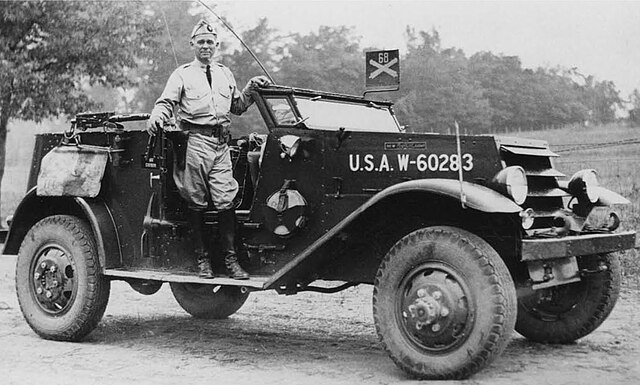
The scout car M2 was based on the Corbitt 1.5-ton truck, and powered by the Lycoming's "Corbitt Eight" MODGFC 94-horsepower V8 engine. The vehicle weighted 7,900lb (3,600kg) for a top speed of 58mph (93kph), range 200 miles (320km), crew of 5-7 men. Armour protection consisted of 0.5 inches (1.3cm) plates forward, 0.25 inches (.64cm) sides and rear. There were four brackets in all to mount .30cal machine guns only at the start, two on each side. 22 M2s, including prototypes came out until 1935 and March 1938.
It was followed by the 4x4 scout car M2A1 made by the White Motor Company, featuring the Tourelle skate mounts for machine guns instead of external pintle mounts but production was short, with just 100 manufactured in 1937-39 before the denomination was changed to M3 with simplifications and modifications for mass production.
For other sources, only 60 M2 Scout Car were made in 1937-39 before a better model was thought of for massive production once the war started in September 1939. The M2 however had most trademarks found later, but the engine, weaker, and a heavy Browning 0.5 HMG plus one 0.3 Browning LMG.
Specs:
None found so far. See the M3. White M3 Scout Car (1940)
White M3 Scout Car (1940)
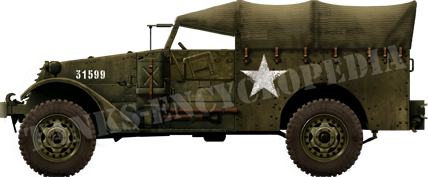
The White M3 Scout Car followed the 1937-39 M2 scout car, to better meet new U.S. Army and lend-lease need for a fast and agile armored reconnaissance vehicle, uysing a better engine and reinforced commercial truck chassis, larger flatbed, and produced by the White Motor Company to c20,000 vehicles until 1945. As standard armament It had a forward-mounted .50 cal. Browning M2 HMG and .30 caliber M1919 Browning LMG on a pintle mount at the rear or two either side. Armament varied depending on the specific version and modifications, but unlike the hakf-tracks, payload was limited so none received a heavy ordnance.
This vehicle had relatively light armor, providing protection against small arms fire and shell splinters only, and was open top. The forward crew compartment housed the driver and co-driver and additional crew members or cargo at the rear. It kept the 4x4 wheeled configuration of the M2, and was widely used by the U.S. Army and other Allied forces during World War II, used in reconnaissance missions and transporting personnel and supplies. There were variants such as command cars, armored ambulances, mortar carriers. The M3A1 had a redesigned hull for improved crew visibility. Postwar it continued to serve in various capacities and with different armies around the world well until the 1970s in some cases.
Specs:
See the main article Marmon-Herrington T13 (M4) Scout Car (1937)
Marmon-Herrington T13 (M4) Scout Car (1937)
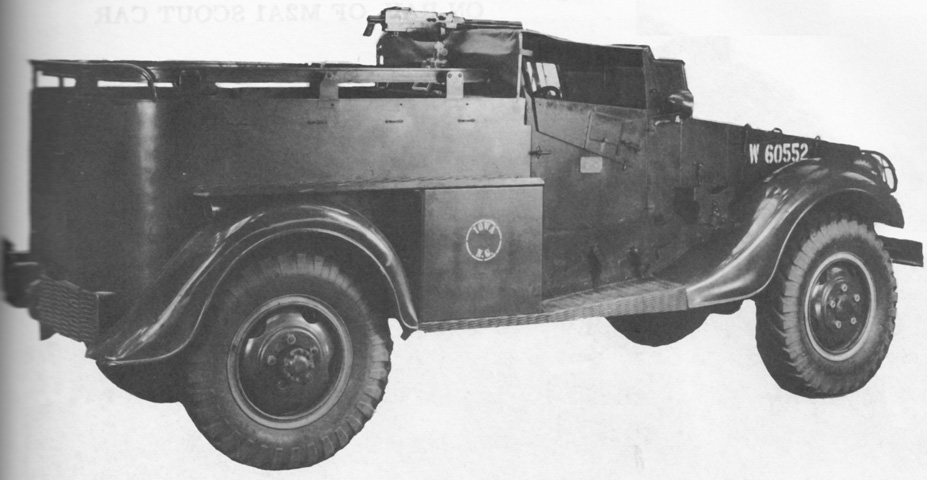 The scout car M4 was derived from a prototype based on a Ford/Marmon-Herrington 1.5-ton commercial truck tested in comparative trials with the White Scout car M2A1. It was found inferior and not accepted for the US Army, albeit it was standardized as M4 and manufactured in small numbers (38) for the National Guard, but using soft steel plating for the hull. Prototype designation was T13. It had a large, boxy compartment at the rear, with rounded corners back, upper extensions and only four seats, two for the driver/co-driver forwards, two aft, and was armed with two 0.3 Browning M1919 but in some case the 0.5 HMG as well, on pintles. It was still in service in WW2, albeit never leaving US soil.
The scout car M4 was derived from a prototype based on a Ford/Marmon-Herrington 1.5-ton commercial truck tested in comparative trials with the White Scout car M2A1. It was found inferior and not accepted for the US Army, albeit it was standardized as M4 and manufactured in small numbers (38) for the National Guard, but using soft steel plating for the hull. Prototype designation was T13. It had a large, boxy compartment at the rear, with rounded corners back, upper extensions and only four seats, two for the driver/co-driver forwards, two aft, and was armed with two 0.3 Browning M1919 but in some case the 0.5 HMG as well, on pintles. It was still in service in WW2, albeit never leaving US soil.
Specs:
Weight: 7,710lbs (3,500kg), Length 190 inches (4,80 m).Armour: Front 0.25 in (0.64mm), as sides and rear.
Ford V8 4 cycle, gasoline 85 hp, 60 mph (100 kph) ~250mi (400km) range, leaf spring suspension.
Armament, 1x 0.5 in HMG and/or 2x pintle mounted Browning 0.303 in M1919 on rail, with modified C-12 adapter and type H1 ammunition holder.
 Trackless Tank (1940)
Trackless Tank (1940)
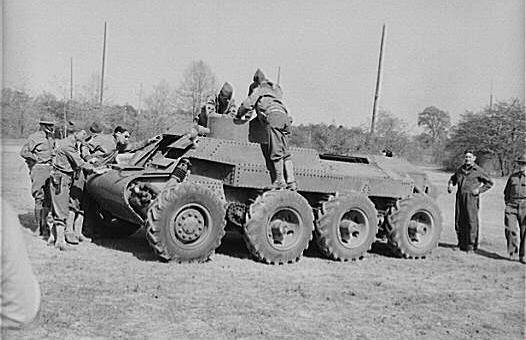
A pure prototype in the line of convertible tanks by Christie in the 1920s such as the M1931. Tested in 1940-1941 by the "Trackless Tank Corporation". This was their first vehicle, derived by January 1941, into another eight-wheeled vehicle tested at Aberdeen. It was unsatisfactory as a tank, but the performance of the eight-wheel configuration with pneumatic strut and independent generated a lot of interest from the procurement board and officers. Additional tests at Fort Knox completely pushed forward what an armored car could do, and the "Trackless Tank" in fact had better capabilities than many other armored vehicle tested at the arsenal. It could carry a crew of 4 and had an armament (never fitted) of one or two .30 or .50 cal Machine Gun. It was powered by 9 Cylinder Radial Diesel and became the predecessor of what was later to the later T13/T13E1 Armored Car. A contact was negotiated for an armored car based on this design indeed.
Specs:
Unknown, close to T13. The one tested at Fort Knox in March 1941 had instead of a turret, a small open shield with a 0.3 Browning LMG. T13/T13A1 Trackless AC (1942)
T13/T13A1 Trackless AC (1942)
Following the vehicle above, the Trackless Tank Corporation started working later in 1941, under contract to a more elaborated prototype which could interest the army for a contract. This was the same which was a widepread specification sent across the US to all manufacturer, spwaning many wartime reconnaissance armoured car prototypes. Ford wong in the end with the M8, but all these vehicles needed to have a 37 mm in turret. For specs, see below. Tests started at Fort Knox on 7 June 1942. But the vehicles had one-off components and failed multiple times while despite outstanding performance, the much heavier weight had the power train overwhelmed. Untimately the programme was cancelled , along with all variants.
Specs:
T13: Wheel sprung independently, rear six chain driven, powered by a Guiberson T-1020 diesel engine for 7.5 tons. Light tank-type turret, 37 mm gun. Four completed as gun motor carriages. December 1941: additional two chassis ordered as howitzer motor carriages.T13E1: Two modified pilots authorized in April 1942. Chassis were lengthened for 12x20 combat tires and W-670-9A gasoline engine.
 Ford T2 Observation Post Tender (1941)
Ford T2 Observation Post Tender (1941)
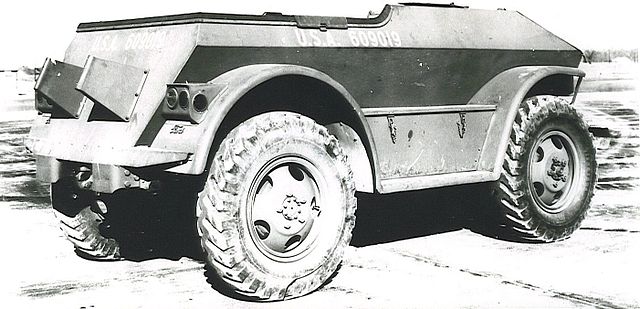
Photo Credit: U.S. Army; via David R. Haugh - Oregon USA, wikimedia cc
A rare vehicle designed very specifically to supply forward posts in a frontline as indicated. Still a WWI mentality vehicle, relatively similar in concept to tracked vehicles such as the Renault UE but more intended for artillery positions, used by field artillery units. Designed by the Ford Motor Company for the US Signal Corps it was a stocky 4x4 vehicle with a crew of 3, powered with a 6-cylinder gasoline and unarmed. Single prototype. It followed the T1 Observation Post Tender based on a modified T8 37mm GMC chassis. No production.
Specs:
Same as the T8 37 mm GMC 4x4 Ford, 3 tons (estimated), 153 in x 80 in x 60 in, wheelbase 92 in. The 226 cu in liquid cooled engine provided 90 hp, with a 4/1 gearbox, top speed below 50 mph (the unladen T8 was capable of 60 mph). M8 Greyhound (1942)
M8 Greyhound (1942)
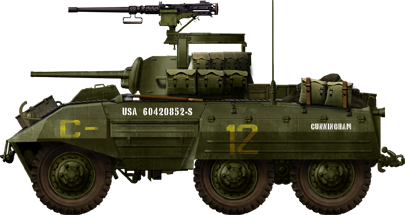
The "Grey Ghost" was declared the winner of the largest wartime competition for a reconnaissance armoured car. Ford produced more than 8500 of them, which arrived on the battlefield in 1943. Since 1940, the main antitank, all-terrain fast vehicle in service with the US Army was the M6 GMC. It was a basic 6 wheeled truck equipped with a 37 mm (1.46 in) gun installed on the rear bed, only protected by a frontal mask. The crew was exposed, and the M6 was lightly protected. Despite this, it remained in service until 1945. But its deficiencies led the US Army ordnance department to launch the development of a new vehicle in July 1941.
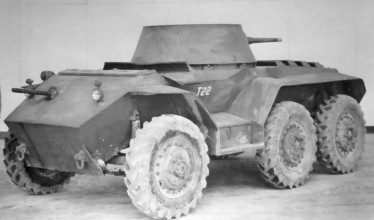
T20 Prototype tested in 1942
The requirements asked for a 6x6 with better off-road capabilities, entirely armored, with the 37 mm (1.46 in) gun protected by a turret, and a better anti-personal, close-combat armament, which included a combination of a heavy .50 (12.7 mm) and a .30 (7.62 mm) caliber machine-guns. The glacis sloped armor was designed to withstand 13 mm (0.51 in) heavy machine gun fire. Once the specifications were made public, Studebaker, Ford and Chrysler submitted their designs, named respectively T21, 22 and 23, all of them very similar in appearance. Tests at Aberdeen lasted until until March 1942, but production was still delayed until March 1943 based on the T22E2, after testing the T22, and T22E1, the latter judged superior to its competitors. The later M8A1 only had improved suspensions and only two prototypes were made, despite the standardization denomination.
Specs:
Dimensions 5 x 2.53 x 2.23 m, 8.6 short tons, Crew 4 (driver, commander/radio, gunner, loader)Propulsion: Hercules JXD 6-cyl gasoline, 110 hp (82 kW) of 56 mph (90 km/h), 560 km range
Armament: 37 mm (1.46 in) M6 QF AT gun, cal.50, cal.30 Browning, protection 8-15 mm (0.31-0.59 in).
 M20 Utility Car (1944)
M20 Utility Car (1944)
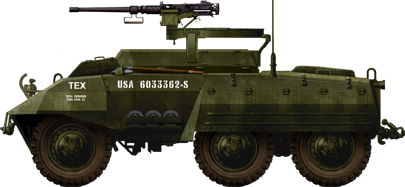
Based on the M8, this vehicle was a turret-less variant with open compartment and larget communication suite, used to lead a M8 unit on the battlefield with a longer range liaison to HQ. This was the main derivative also developed and built by Ford. Its only armament comprised a lowered ring mounting a 0.50 cal (12.7 mm) heavy machine-gun, and stored weapons included a bazooka. It was roomier, and equipped with one or two long range radios. It was also lighter and faster and also served as an APC during the war. In all, Ford delivered 3680 "M20 Scout Car", as it was also known, from early 1943 until late 1944, also exported under Lend-Lease.
Specs:
As M8 but lower height. T69 MGMC (1944)
T69 MGMC (1944)
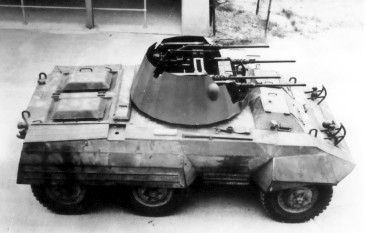
The T69 multiple gun motor carriage started to be developed from late 1943, as an anti-aircraft variant of the M8, armed with four .50-inch machine guns in a turret developed by Maxson Corporation, resuing most components used on the Half-Track variant. However compared to the M16 MGMC this variant was judged inferior and the whole program was closed.
Specs:
Similar to the M8 albeit the vehicle was slighlty lighter. T17E1 Staghound (1942)
T17E1 Staghound (1942)
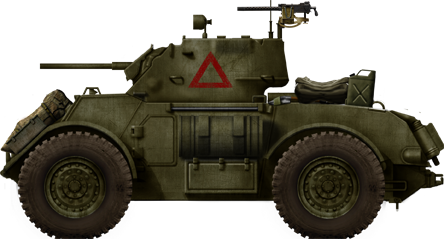
British Staghound in training before D-Day, Spring 1944
The T17E1 Staghound was an armored car used by the Allies during World War II. It was designed and built by the Ford Motor Company in the United States. The Staghound was intended for reconnaissance and armored patrol duties. The T17E1 Staghound was based on a British requirement for a wheeled armored car, the result of collaboration between the United States and the United Kingdom, produced by the Ford Motor Company from 1942 to 1944.
The T17E1 was armed with a 37mm M6 gun in a turret, providing it with the capability to engage light armored vehicles and infantry. It also had a coaxial .30 caliber Browning machine gun and another .30 caliber machine gun in the hull. It featured sloped armor for increased protection, had a top speed of around 55 mph (88 km/h) making it relatively fast for its time in a 4x4 wheel configuration, enhancing off-road capabilities.
The T17E1 had a small cast 3-man turret, but the T17E2 was tested with the M8 Scott 3-in Howitzer gun open turret for support (not produced) and others. All were were equipped with radio equipment and they served with Commonwealth and British Empire forces, British Army, Canada and other Allied nations. The first saw action at the end of the North African campaign, in Italy, and Northwestern Europe until V-Day.
Postwar, many surplus Staghounds were exported to various countries and saw action in different conflicts, remaining in service for several years. Some were also used for internal security duties. The T17E1 Staghound proved a solid and probabl more sturdy alternative to the M8 Greyhound. It was a versatile armored car providing reconnaissance and fire support capabilities to Allied forces during the war and beyond, combining ease of maintenance and reliability, speed, firepower, and mobility championed on the battlefield.
Specs:
Weight: 14,000 kg Dimensions: 5,49 x 2,69 x 2,36 m Armor: from 13 mm to 51 mm Power: 2x 6-cylinder GMC 270, 194 hp (144 kW), 89 km/h RA 724 km Armament: 37 mm M6 gun + 2-3 7,62 mm LMGs Crew/production: 5 (cdr, driver, gunner, loader, MG-gunner); 4,094 T17E2 (1943)
T17E2 (1943)
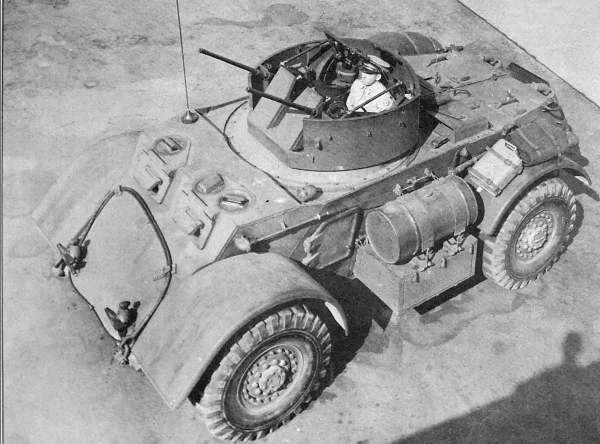
The Car, Armored, T17E2, was the main variant of the T17E1 Staghound, modified as AA vehicle, entering service in October 1943 (general assumption) with some 1,000 prdered to Chevrolet. Its US Supply Catalog Designation is the same as the T17E1, G122, as its chassis and all components. However the only change is the replacement of its main turret by a new open-top semi-turret with a twin mount and two .50 BMG Browning M2HB (2610-5250 rounds), with a traverse of 360° @ 43°/s (360° in 8.372s), Fraser-Nash hydraulic Elevation -10° to +80°. The Crew of three (driver, Cdr/gunner, loader) carried its own .45 ACP M1 Thompson (450 rounds) in addition. It also had the same No. 19 radio as the original.
Specs:
As T17E1, but weight 12.7 tons, Turret Ring Diameter 1.1m and height 2.42m. T17E3 (1943)
T17E3 (1943)
The E3 was a T17E1 fitted with the turret of 75 mm Howitzer Motor Carriage M8 Scott, open, with the 75mm M2/M3 short-barrel howitzer. Trials took place by December 1943, but it was not accepted for production. Only a single prototype was made.
Specs:
As the T17E1 but 75mm M2/M3 Howitzer. T18 Boarhound (1942)
T18 Boarhound (1942)
This heavy armoured car was a potential competitor to the T17 lend-lease program, not chosen for production. Built by the Yellow Coach Co. it was a 8x8 armed with a 57 mm gun M1 (standard antitank gun) in a cast enclose turret, and two 8 mm Browning M1919A4, one coaxial, one in the hull. Protection consisted of partly cast and welded elements ranging from 9 mm (deck, roof) to 50 mm forward, to resist 20 mm autocannon rounds and 37 m AP rounds as well. It was closer to a 8x8 tank and inspired by similar eight wheeled heavy German reconnaissance cars.
R&D started in 1942 as a private venture from Yellow Coach Co. and it was developed into the T18 armed with the same 37 mm gun as the T17, the T18E1 6-wheeled version (cancelled January 18, 1943) and finally the 8x8 T18E2 with 57 mm gun. Interest ofthe Army was mild, although 30 were built in total for intensive tests in 1943. Eventually, it was rejected for mass-production for the British, as costly and having lesser performances than the Staghound. One is now on display at Bovington.
Specs:
26.8 t, 6.2 x 3.1 x 2.6 m (20 ft 4 in x 10 ft 2 in x 8 ft 6 in)Armor: 9.5 to 50.8 mm, crew 5, powered by 2x GMC 6-cylinder for 250 hp p/w 9.4 hp/t
Performances: Top speed 80 km (50 mph) and range 400 km (250 mi)
 Chevrolet T19 (1942)
Chevrolet T19 (1942)
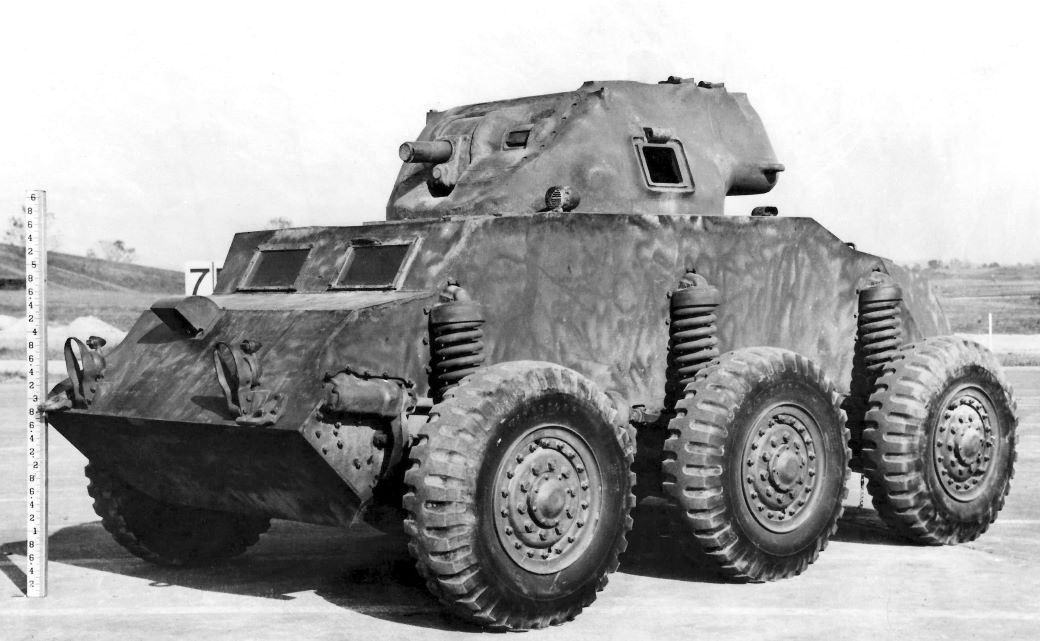
In the wake of the T17 lend-lease armoured car program for the allies, Chevrolet proposed the alternative T19 which was also evaluated. Only two were completed for tests, and they used a different hull than the Staghound, but same cast turret with a 37 mm gun. Main difference was its engine and three axles drivetrain. Testing showed it too heavy however for the reconnaissance role, so the protoypes were modified to make it lighter, and this led to the development of the very different T19E1 was built (one completed) see below.
Specs:
Dimensions and weight unknown, 6-Cylinder Gasoline, crew 5, 37mm Cannon and Co-Axial: .30, Hull .30 cal MG Chevrolet T19E1 (1943)
Chevrolet T19E1 (1943)
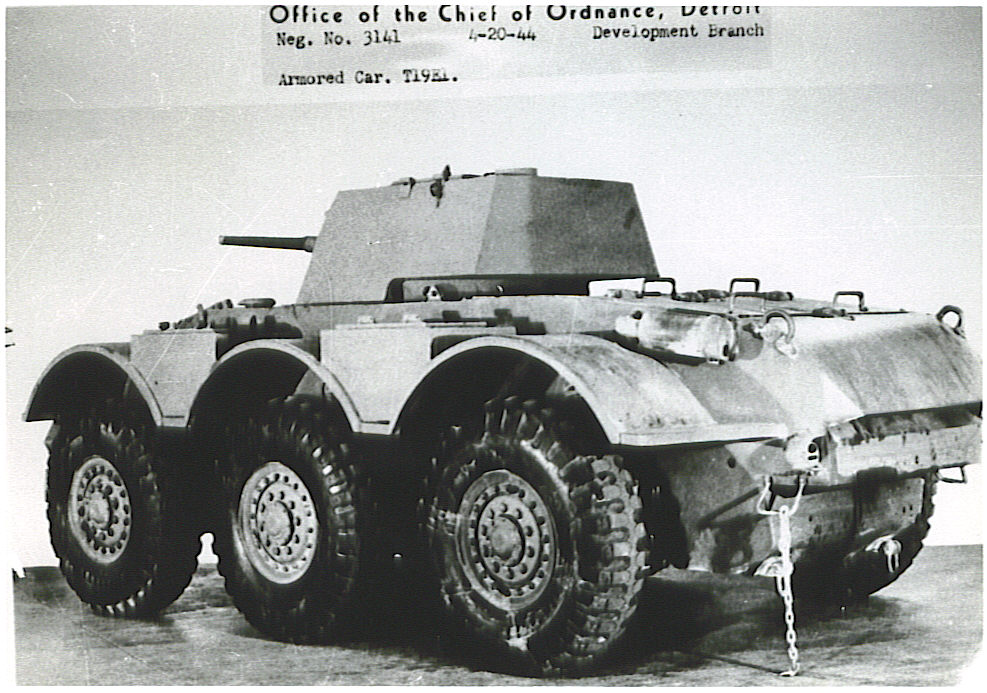
Improvements made on the T19 consisted in a redesigned hull and new, large but open welded turret, and a new, more powerful engine. Testing showed it still too heavy for a reconnaissance role, albeit the chassis seemed right and the US Tank Destroyer Command asked to add on it a M3 75mm gun in a new open turret, designated T66 75mm Gun Motor Carriage. Both the T66 GMC, and T19E1 was tested by the British Desert Warfare Board as the war in Africa still raged on. They found these superior to the T17E1 Staghound however soon the North African campaign concluded, and any order was cancelled.
Specs:
Weight 28,500 lbs (12,939kgs), 220 x 120 x 95.5 in (5,58 x 3,05 x 2,42 m)Powerplant: Two 8-Cyl gas. liquid cooled GMC with 4/1 automatic gearbox 300 hp
Top speed 55 mph (88 kph), range 300 miles (480 km)
Protection: 0.375-0.5 in (9.53-12.7mm)
 Chevrolet T66E1 (1943)
Chevrolet T66E1 (1943)
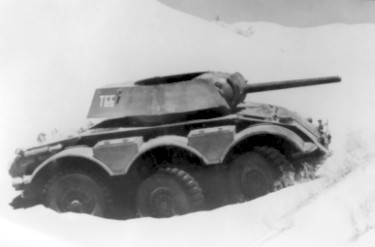
Ultimate evolution of the T19E1, with a M3 75 mm gun in a new all-welded open-topped turret for better visibility. For the US Tank Destroyer Command it was almost a possible wheeled equivalent to the M10 Wolverine. However the T66 75mm Gun Motor Carriage, despite generally good performance and later judged good by the British Desert Warfare Board was still deemed too heavy for reconnaissance vehicle and not adopted, especially when the North Africa campaign was now over.
Specs:
Heavier than the T19E1, non precise data found. Studebaker T23 (1943)
Studebaker T23 (1943)
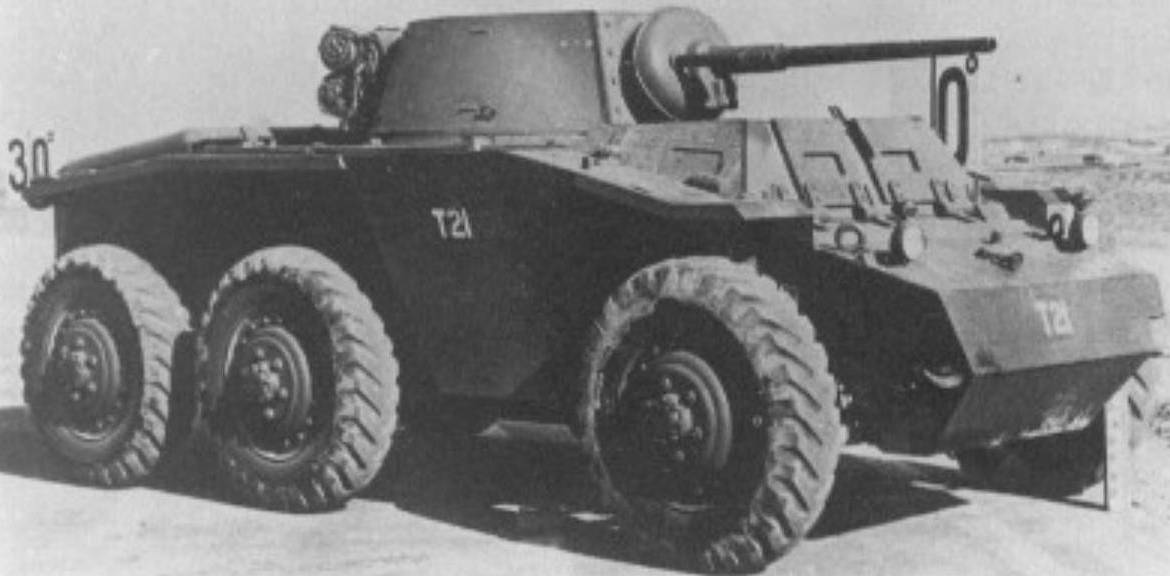
Light armored car T21, previously classified as "37mm gun motor carriage T43" before March 1942. Development of the T22 and T23 started on October 1941, pilot made by Ford and the Fargo Division of Chrysler Corp. Studebaker made its own pilot based on the same characteristics, at no cost to the Government for testings. The Special Armored Vehicle Board reported in December 1942,not ready for production as many fixes were needed. Eventually the Chrysler T22E2 was chosen for it, standardized as the M8.
Specs:
17,200 pounds (7,81 ton) fully loadedHercules 6-cylinder engine of 112 horsepower
37mm gun, .30 LMG. Crew 4, armor .875 to 1.125 inches (22.3 to 28.6mm)
 Studebaker T27 (1944)
Studebaker T27 (1944)
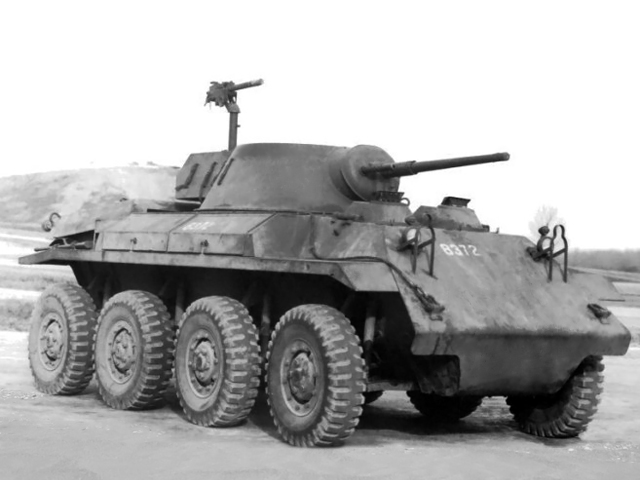
A 8x8 heavy armoured car armed with the same turret, revised as on the M8 Greyhound, 37 mm gun and one M1919 LMG. Crew 4, only one made, not adopted. The T27 Armored Car prototype was developed by Studebaker in 1944. It had its first, second and fourth pairs of wheels powered, a crew of four, two .30 caliber LMG (coax and AA) plus the turret 37 mm cannon. It was Powered by a Cadillac gasoline 8-cyl engine. Only two were made and tested, as possible replacement for the M8 Greyhound, the first ready by late 1943. It was tested against the T28 Armored Car at Aberdeen Proving Grounds. Both were superior to the M8, but still the T28 was judged superior overall, designated the M38, but cancelled afterwards as the Army found the M8 beinbg in sufficient numbers and the war in Europe was goinf to an end.
Specs:
Cadillac 8-cylinder gas. engine, 8×6 wheel, crew 4. Willys T24 Scout Car (1941)
Willys T24 Scout Car (1941)
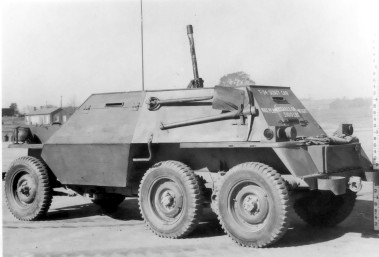
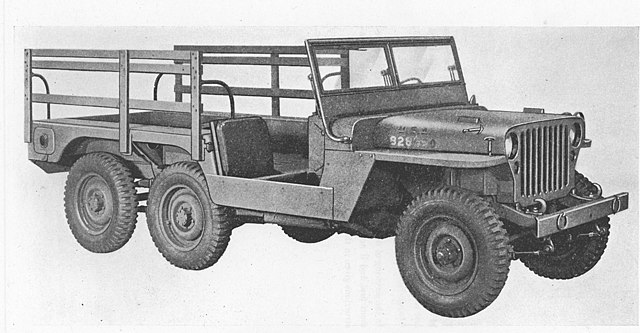
The T24 Scout Car was based on the chassis of the Carriage, Motor, 37-mm Gun, T14 and requested by the Tank Destroyer Command, but the program went nowhere.
Specs:
Similar in size to the Willys MT-Tug, weight unknown14ft long, 0.5 Browning M1920 HMG in a pintle mount, rear compartment.
 Willys T25 Scout Car (1942)
Willys T25 Scout Car (1942)

"Super Jeep II", 6x6 conversion of the classic GP by Willys. The company Smart, specialized in armored cash transport vehicles and personnel, proposed a prototype based on the MT-Tug 6X6 Willys chassis. Unfortunately production was not authrized despite a later prototype having larger 7.50 x 16 tires. The name of the base vehicle was known as the "MT-TUG". "MT-A, "MT-C", and "T-24" but in US service, standardized as the "Willys MT-TUG 3/4 ton truck 6x6 tractor".

Photo: T25E1 4x4.
Specs:
A previous T24 but 6600 ibs. fully laden. Baker 8x8 "Jumping Tank" (1941)
Baker 8x8 "Jumping Tank" (1941)
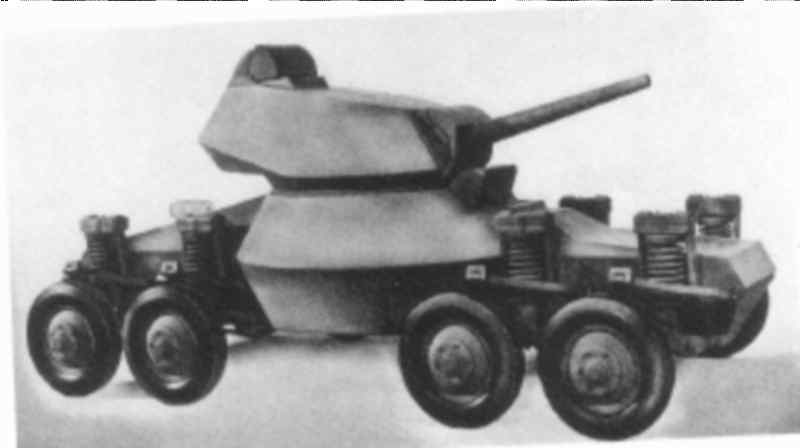
Prototype by Baker automobiles of a convertible 4x4/8x8 vehicles with special suspensions for high speed runs and armed with a 40 mm Bofors as main armament. Two variants were tested, open and with a prismatic cast turret armed this time with the 75 mm or 17 pdr gun. Tested both in 4x4 and 8x8 configurations. Baker Manufacturing Co. proposed in deed to fit in a 3 Inch Cannon (17 Pounder).
Specs:
Unknown, variable if 4x4 or 8x8. Chrysler 4x4 1/2 ton scout car (1941)
Chrysler 4x4 1/2 ton scout car (1941)
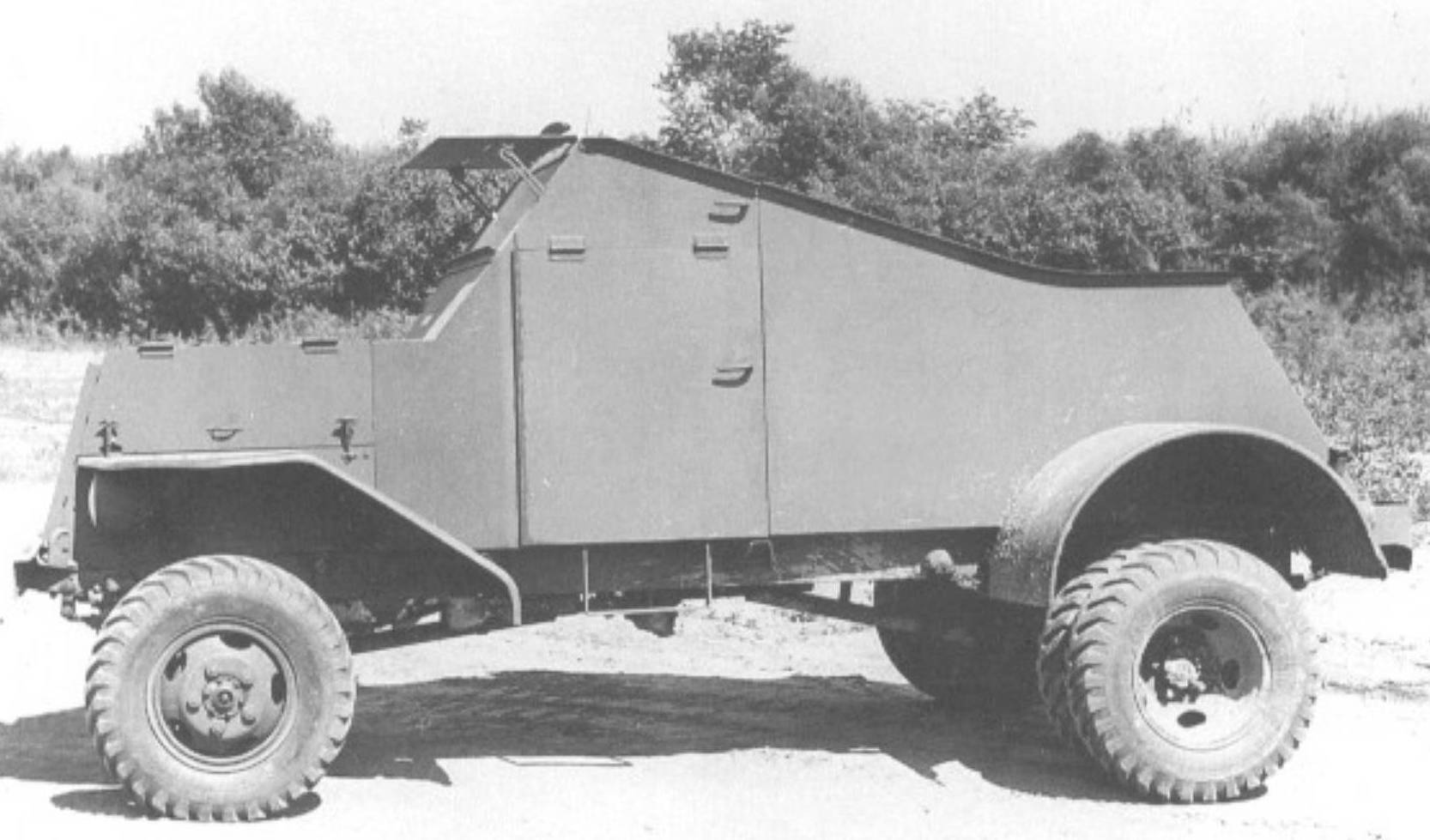
Chrysler tried to test and market a "bolt-on" armored vehicle, usable for convoy escort or protected personnel carrier. But it had too high a center of gravity while being too narrow and proved dangerously unstable. Tested by the U.S. Signal Corps. Not adopted.
Specs:
Unknown. Tucker Tiger (1938-42)
Tucker Tiger (1938-42)
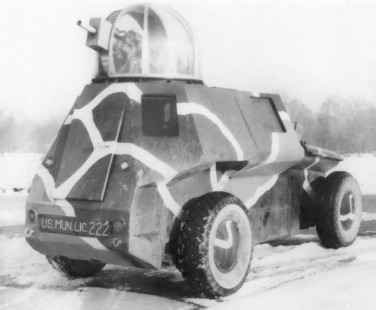
This model showed promises as well, being capable of an astonishing 114 mph on level road and 78 mph over rough terrain thanks to an humongus power-to-weight ratio. It was on,e of several high-speed armored car tested by the Army. They had V12 engine, were to be armed with a 37-millimetre (1.5 in) AA gun capable (120 rpm) in a spherical gun turret aft. A hull-mounted machine gun was also tested. Preston Tuckon even sold it as an "aircraft hunter". This development led to a movie made long after the war. Three prototypes made and tested from 1938 to 1942, the last having a Browning 0.5 cal. in a bubble canopy turret at the rear. Another sported a twin Browning M1919.
Specs:
Unknown. T230 Fargo (1942-43)
T230 Fargo (1942-43)
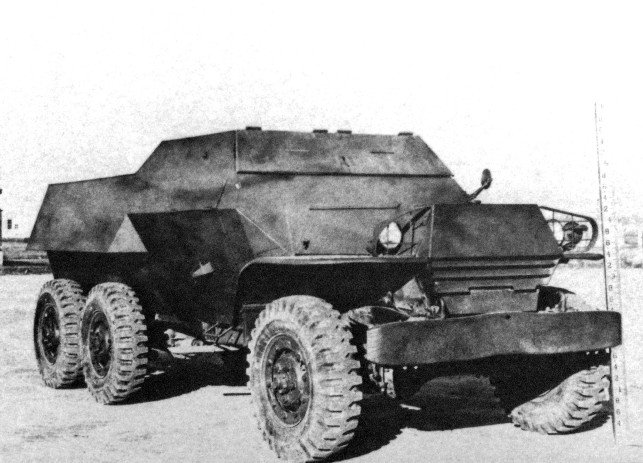
A 6x6 armoured truck based on a Dodge WC62 6x6 1 1/2 Ton "Fargo" truck chassis + engine and gearbox. The first proposal was to fit a Maxson AA turret, but later the vehicle was repurpose as a scout, and later armored ambulance/ammunition carrier. The two prototypes were tested but denied production.
Specs:
Unknown, chassis lenght like the 6x6 Fargo. Cook Brothers T55 "Interceptor" (1943)
Cook Brothers T55 "Interceptor" (1943)

A 8x8 chassis proposed as a private venture to the US Tank Destroyer Command, self-propelled gun with the stock 76.2 mm or 3-in M1918 main gun and a cal.50 M2HB, top speed 80 kph/50 mp, crew 5, two prototypes tested. It was called in the press the "Cook Interceptor Mark I". Refused, another prototype with a reshaped hull had the crew better protected, but same gun. It was called the "Cook Interceptor II". Not chosen for production at that stage in the war, because the whole concept of tanks destroyers was abandoned.
Specs:
Unknown. M38 Wolfhound (1944)
M38 Wolfhound (1944)
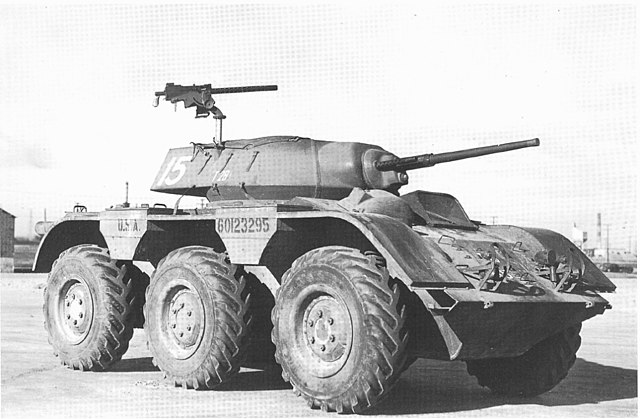
The M38 Wolfhound was a 6×6 vehicle created by the Chevrolet division of General Motors as replacement for the M8 Greyhound and in development from mid-1944 to the end of the war in Europe by May 1945, leading to the cancellation of the project after a few prototype were tested. It had a crew of four, a 37 mm gun in rotating open-topped turret, 93 rounds two machine guns (co-axal and AA pintle). The powerplant was the most innovative, a single Cadillac V8 gas. water-cooled engine. The chassos was compact and it had three large tires, distinctive curved mudguards, well sloped frontal glacis plate and improved radio. There were even tests with the Chaffee turret which seemed more promising. Although the program was cancelled, the M38 layout perhaps inspired the postwar Alvis Saladin.
Specs:
6.9 t, 5.11 x 2.44 x 1.98 m (16 ft 9 in x 8 ft x 6 ft 6 in)Crew: 4, armor 6 to 12 mm (0.3 to 0.5 in), 37 mm M6 gun, 2x 0.3 in LMG
Cadillac 42 V-8 19.3 hp/tonne, 97 km/h (60 mph) RA 483 km (300 mi)
Read More
roadandtrack.com/ tuckercartalana.com
warwheels.net
On the deerhound
ww2 us AC TE
Development of US Armoured Vehicles in WW2, vol.II (pdf)
otm-uswot.blogspot.com
Trackless_tank

WW2 Tanks




























WW2 tanks posters

All Tiger tanks liveries.

Panther liveries and variants

WW2 Armour - All tanks











Tanks aces and single tanks series

Find more there

Museums, Movies, Books & Games
The Tanks and Armor in pop culture
Tanks and armored vehicles in general are only really grasped when seen first person: The mass, the scale, it's all there. Explore also the way tanks were covered in the movie industry, in books and in video games.Movies:
Best tanks movie on warhistoryonline.com
On imdb.com
On bestsimilar.com/
miltours.com
liveabout.com/
watchmojo.com
Video Games:
pcgamesn.com
historyhit.com
levvvel.com
vg247.com/best-tank-games
mmobomb.com/
alienwarearena.com

